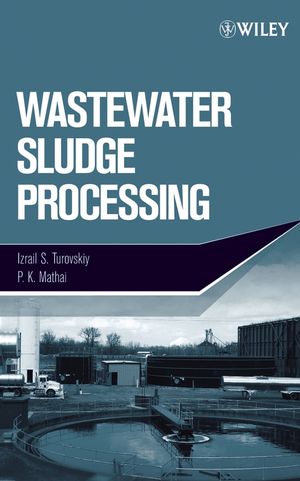Wastewater Sludge ProcessingISBN: 978-0-471-70054-8
Hardcover
354 pages
June 2006
 This is a Print-on-Demand title. It will be printed specifically to fill your order. Please allow an additional 10-15 days delivery time. The book is not returnable.
|
||||||
Preface xi
About the Authors xii
1 Introduction 1
1.1 Introduction, 2
1.2 40 CFR Part 503 Regulation, 2
1.2.1 General Provisions, 3
1.2.2 Land Application, 5
1.2.3 Surface Disposal, 11
1.2.4 Pathogen and Vector Attraction Reduction, 18
1.2.5 Incineration, 27
2 Sludge Quantities and Characteristics 30
2.1 Types of Sludge, 31
2.1.1 Primary Sludge, 32
2.1.2 Secondary Sludge, 32
2.1.3 Chemical Sludge, 32
2.1.4 Other Wastewater Residuals, 33
2.2 Sludge Quantity, 34
2.2.1 Primary Sludge, 34
2.2.2 Secondary Sludge, 36
2.2.3 Activated Sludge, 36
2.2.4 Attached Growth System Sludge, 42
2.2.5 Chemical Sludge, 43
2.3 Sludge Characteristics, 44
2.3.1 Primary Sludge, 44
2.3.2 Activated Sludge, 46
2.3.3 Physical and Biological Properties, 47
2.4 Mass Balance, 49
3 Thickening and Dewatering 60
3.1 Introduction, 61
3.2 Conditioning, 62
3.2.1 Factors Affecting Conditioning, 62
3.2.2 Chemical Conditioning, 64
3.2.3 Other Conditioning Methods, 77
3.3 Thickening, 81
3.3.1 Gravity Thickening, 81
3.3.2 Dissolved Air Flotation Thickening, 88
3.3.3 Centrifugal Thickening, 94
3.3.4 Gravity Belt Thickening, 99
3.3.5 Rotary Drum Thickening, 102
3.3.6 Miscellaneous Thickening Methods, 102
3.4 Dewatering, 106
3.4.1 Centrifugal Dewatering, 106
3.4.2 Belt Filter Press, 110
3.4.3 Pressure Filter Press, 116
3.4.4 Drying Beds, 121
3.4.5 Other Dewatering Methods, 127
4 Aerobic Digestion 136
4.1 Introduction, 137
4.1.1 Process Theory, 138
4.2 Conventional Aerobic Digestion, 141
4.2.1 Process Design Considerations, 144
4.2.2 System Design Considerations, 147
4.2.3 Operational Considerations, 155
4.3 Process Variations, 156
4.3.1 High-Purity Oxygen Digestion, 157
4.3.2 Low-Temperature Aerobic Digestion, 157
4.3.3 Dual Digestion, 157
4.3.4 Mesophilic Aerobic Digestion, 158
4.3.5 Autothermal Thermophilic Aerobic Digestion, 158
4.3.6 Technological Improvements, 164
5 Anaerobic Digestion 173
5.1 Introduction, 174
5.1.1 Advantages and Disadvantages, 174
5.1.2 Theory of Anaerobic Digestion, 175
5.2 Environmental Factors, 176
5.2.1 Solids and Hydraulic Retention Times, 177
5.2.2 Temperature, 177
5.2.3 pH and Alkalinity, 179
5.2.4 Toxic Materials, 180
5.3 Process Variations, 182
5.3.1 Low-Rate Digestion, 182
5.3.2 High-Rate Digestion, 183
5.3.3 Thermophilic Digestion, 185
5.3.4 Two-Stage Digestion, 185
5.3.5 Two-Phase Digestion, 186
5.4 Process Design, 188
5.4.1 Per Capita Basis, 188
5.4.2 Solids Loading, 189
5.4.3 Solids Retention Time, 189
5.4.4 Volatile Solids Reduction, 190
5.4.5 Gas Production, 190
5.5 System Component Design, 191
5.5.1 Tank Design, 191
5.5.2 Digester Covers, 193
5.5.3 Mixing, 193
5.5.4 Heating, 197
5.5.5 Gas Usage, 200
5.6 Operational Considerations, 205
5.6.1 Reactor Performance, 205
5.6.2 Odor Control, 207
5.6.3 Supernatant, 207
5.6.4 Struvite, 209
5.6.5 Digester Cleaning, 210
6 Alkaline Stabilization 213
6.1 Introduction, 213
6.1.1 Advantages and Disadvantages, 214
6.1.2 Process Theory, 215
6.2 Process Application, 217
6.2.1 Liquid Lime Stabilization, 217
6.2.2 Dry Lime Stabilization, 218
6.2.3 Advanced Alkaline Stabilization Technologies, 220
6.3 Process Design, 221
6.3.1 Sludge Characteristics, 221
6.3.2 Contact Time and pH, 222
6.3.3 Lime Dosage, 222
6.3.4 Alkaline Material Storage, 223
6.3.5 Lime Feeding, 224
6.3.6 Liquid Lime Mixing, 226
6.3.7 Dry Lime Mixing, 227
6.4 Process Performance, 231
6.4.1 Odor Reduction, 231
6.4.2 Pathogen reduction, 232
6.4.3 Dewatering Characteristics, 233
7 Composting 235
7.1 Introduction, 236
7.1.1 Composting Process, 236
7.1.2 Composting Methods, 237
7.1.3 Advantages and Disadvantages of Composting, 239
7.1.4 Zoological Characteristics of Compost, 239
7.2 Process Description, 240
7.2.1 Factors Infl uencing Composting, 240
7.2.2 Windrow Process, 243
7.2.3 Aerated Static Pile Process, 244
7.2.4 In-Vessel Process, 246
7.2.5 Design Considerations, 249
7.3 Theoretical Aspects of Composting, 252
7.4 New Technology in Composting, 259
7.4.1 Organic Content, 259
7.4.2 Odor, 261
7.4.3 Temperature and Moisture, 261
7.4.4 Composting Mixture, 262
7.4.5 Composting Process Control, 263
7.4.6 pH, 266
7.5 Examples of Composting in Europe, 267
7.6 Examples of Composting in the United States, 272
8 Thermal Drying and Incineration 277
8.1 Introduction, 278
8.2 Thermal Drying, 278
8.2.1 Methods of Thermal Drying, 278
8.2.2 Design Considerations, 287
8.3 Incineration, 290
8.3.1 Methods of Incineration, 291
8.3.2 Design Considerations, 298
9 Comparison of Energy Consumption 304
9.1 Introduction, 304
9.2 Anaerobic Digestion, 304
9.3 Incineration, 306
9.4 Composting, 309
9.5 Comparison of Thermal Drying and Composting, 310
9.6 Conclusion, 313
10 Beneficial Use of Biosolids 314
10.1 Introduction, 315
10.2 Requirements for Beneficial Use, 317
10.2.1 Pollutant Limits, 317
10.2.2 Pathogen Reduction, 318
10.2.3 Vector Attraction Reduction, 318
10.2.4 Management Practices, 320
10.2.5 Surface Disposal, 320
10.3 Land Application, 321
10.3.1 Site Evaluation and Selection, 322
10.3.2 Design Application Rates, 322
10.3.3 Application Methods, 328
10.3.4 Application to Dedicated Lands, 329
10.3.5 Conveyance and Storage of Biosolids, 330
10.4 Beneficial Use of Biosolids in Russia, 333
10.4.1 Pathogens, 333
10.4.2 Heavy Metals, 336
Appendix Units of Measure 343
A.1 Abbreviations for SI Units, 343
A.2 Abbreviations for U.S. Customary Units, 344
A.3 Conversion from SI Units to U.S. Customary Units, 344
A.4 Conversion from U.S. Customary Units to SI Units, 346
Index 349



